夏季青藏高原大气热源低频振荡与南亚高压东西振荡的关系
2016-07-27王黎娟葛静
王黎娟 葛静
南京信息工程大学气象灾害教育部重点实验室/气候与环境变化国际合作联合实验室/气象灾害预报预警与评估协同创新中心/气候模拟与预测科技创新团队,南京210044
夏季青藏高原大气热源低频振荡与南亚高压东西振荡的关系
王黎娟 葛静
南京信息工程大学气象灾害教育部重点实验室/气候与环境变化国际合作联合实验室/气象灾害预报预警与评估协同创新中心/气候模拟与预测科技创新团队,南京210044
摘 要利用1983~2012年NCEP/NCAR逐日再分析资料对夏季青藏高原大气热源和南亚高压东西振荡的低频特征以及两者的关系进行了讨论,发现夏季青藏高原东部大气热源与南亚高压纬向运动的主要低频周期都是10~20 d。在高原东部大气热源10~20 d振荡峰值位相,青藏高原上空被低频气旋控制,高原西部被低频反气旋控制,导致南亚高压主要高压中心向西移动呈伊朗高压模态;在大气热源10~20 d振荡谷值位相,低频环流形势完全相反,青藏高原上空被低频反气旋控制,高原西部被低频气旋控制,致使南亚高压主要高压中心向东移动呈青藏高压模态。高原热力场异常导致其上空暖中心变化从而引起的高层风场变化可以解释南亚高压的东西振荡。
关键词青藏高原 大气热源 准双周振荡 南亚高压 东西振荡
王黎娟,葛静. 2016. 夏季青藏高原大气热源低频振荡与南亚高压东西振荡的关系 [J]. 大气科学, 40 (4): 853−863. Wang Lijuan, Ge Jing. 2016. Relationship between low-frequency oscillations of atmospheric heat source over the Tibetan Plateau and longitudinal oscillations of the South Asia high in the summer [J]. Chinese Journal of Atmospheric Sciences (in Chinese), 40 (4): 853−863, doi:10.3878/j.issn.1006-9895.1509.15164.
1 引言
南亚高压,是北半球夏季出现在青藏高原及邻近地区对流层高层、除极地涡旋外最强大、最稳定的控制性环流系统(Mason and Anderson, 1963),其显著的季节变化及夏季的东西振荡对亚洲区域的天气、气候 (陶诗言和朱福康,1964)乃至亚洲夏季风的活动都有重要的影响(Wei et al., 2014, 2015)。
二十世纪六十年代早期,陶诗言和朱福康(1964)就指出夏季南亚高压具有绕其平均位置作东西往返运动的特征。八十年代初,罗四维等(1982)从天气学角度入手,以100°E为界,将南亚高压分为东部型、西部型和带状型,并把东、西部型的相互转换定义为南亚高压的东西振荡。关于南亚高压东西振荡的机理主要存在两种观点:一种是热力作用(自身振荡),由于青藏高原加热作用使得副热带流型发生调整,并在东部平原潜热加热的影响下,南亚高压发生东西振荡,在这类振荡过程中,青藏高原的加热是主要因素(钱永甫等,1978);另一种是环流作用(强迫振荡),由于副热带西风急流上长波扰动不稳定发展产生的新旧波的调整,导致南亚高压发生东西振荡(刘富明和魏淑华,2004;谭晶等,2005)。九十年代末,随着资料的丰富,张琼(1999)进一步从气候态的角度研究了南亚高压“东西振荡”,指出盛夏季节南亚高压存在两类平衡态,即伊朗高压模态和青藏高压模态,并将围绕两类平衡态位置的异常振荡定义为青藏高压的东西振荡和伊朗高压的东西振荡,并指出这种东西振荡是在环流调整下高压中心的移动过程。而Zhang et al.(2002)则认为南亚高压双模态间的相互转换不同于过去青藏高压的东西振荡,它既不是环流调整引发的强迫振荡,也不是青藏高原和我国东部平原加热场差异造成的自身振荡,而与青藏高原和伊朗高原上空的非绝热加热过程密切相关。
九十年代末到本世纪初期,国内学者揭示非绝热加热的空间非均匀分布是决定南亚高压位置和强度的关键因素(刘屹岷等,1999;吴国雄等,1999,2002;Wu and Liu,2003;Liu et al.,2004)。南亚高压本身是热力性质的高压系统,具有“趋热性”(Liu et al., 2000; Qian et al., 2002)。Liu et al.(2007)发现夏季青藏高原的强加热使得纬向非对称不稳定发展,从而造成高原上南亚高压的准双周振荡。以上研究皆表明不论从天气学角度还是气候态角度,夏季南亚高压的活动均与非绝热加热过程密切相关。当南亚高压完全移上青藏高原后,东西振荡便成为该时期最主要的活动特征。那么在季节内时间尺度上,夏季青藏高原大气热源与南亚高压之间存在怎样的关系呢?可能原因是什么?本文试图对上述问题做进一步讨论。
2 资料与方法
使用NCEP/NCAR逐日再分析资料,包括:风场、位势高度场、温度场、地面气压场,水平分辨率为2.5°×2.5°,共12层,时间长度为1983~2012年。
采用“倒算法”(Yanai et al., 1973)计算大气视热源,公式如下:

其中,公式左边Q1为大气视热源,方程右边依次为温度局地变化项、温度水平平流项和温度垂直变化项;分别为平均层的温度、水平速度、垂直速度以及位温。将从对流层顶(取为100 hPa)到地面垂直积分,即可得到整层积分的大气视热源
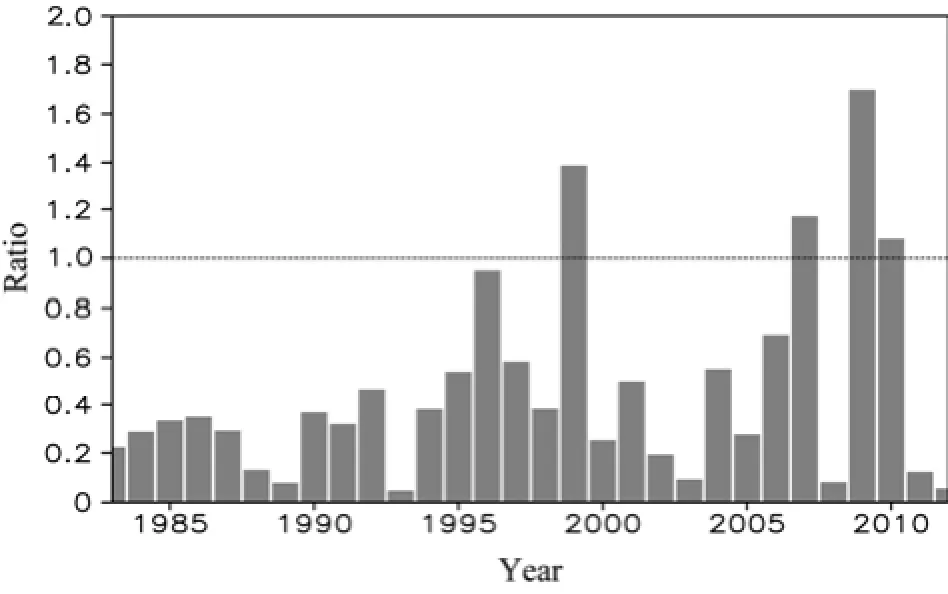
图1 1983~2012年夏季高原东部的30~60 d方差与10~20 d方差的比值Fig. 1 The ratio between 30–60 d and 10–20 d variancesover the eastern TP (Tibetan Plateau) in the summertime during 1983–2012
3 夏季青藏高原大气热源的低频振荡特征
由于高原西部的探空测站远比东部的少,获得的再分析资料可靠性远不如东部,因此这里选用夏季高原东部(27.5°~37.5°N,90°~100°E)大气视热源进行分析。
表1 小波分析夏季青藏高原东部的主要低频周期(通过95%信度检验)Table 1 The main low-frequency period ofin the eastern TP (Tibetan Plateau) during May to September by the Morlet wavelet analysis (at 95% confidence level)

表1 小波分析夏季青藏高原东部的主要低频周期(通过95%信度检验)Table 1 The main low-frequency period ofin the eastern TP (Tibetan Plateau) during May to September by the Morlet wavelet analysis (at 95% confidence level)
主要周期 年份10~20 d 1983 1984 1985 1986 1987 1988 1989 1991 1992 1993 1994 1995 1996 1997 1998 1999 2000 2001 2002 2003 2004 2005 2006 2008 2009 2011 2012 30~60 d 1983 1999 2004 2009
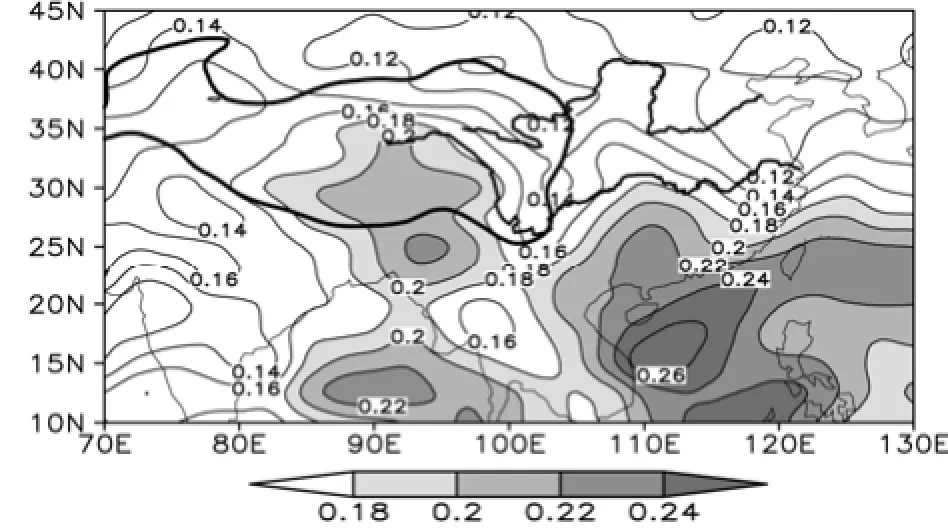
图2 夏季的10~20 d相对方差的多年平均分布(粗实线:海拔高度超过2000 m的青藏高原大地形,下同)Fig. 2 Distribution of 10–20 d relative variance of Q1 in the summer averaged over the period of 1983–2012 (thick solid line indicates the Tibetan Plateau region with topography exceeding 2000 m, the same below)
4 南亚高压纬向运动的频谱特征
4.1 南亚高压纬向位置指数的定义
对于南亚高压东西振荡周期的研究,首先是南亚高压东西振荡指数的确定。刘梅等(2007)采用16760 gpm等值线东脊点的经度定义了南亚高压东伸指数表示南亚高压在东西方向上的位置;赵改英等(2000)用东西两个特定区域的位势高度差表征了南亚高压的东西振荡;王蕊(2008)通过对100 hPa南亚高压中心“重心”位置的计算描述南亚高压的纬向运动。以上对南亚高压纬向运动指数的定义均涉及到了位势高度场,而Yang and Sun(2003)的研究表明,100 hPa位势高度在年际尺度上具有增加的趋势,所以这里参照他们的做法,选择南亚高压东脊点附近(因为东脊点附近曲率涡度大)100 hPa相对涡度均方差大值点(30°N,107.5°E)(图3a),并与北半球其它格点相对涡度求单点相关(图3b),由此确定出描述南亚高压东脊点东西移动的100 hPa相对涡度关键区是(25°~35°N,100°~115°E),将区域平均后的相对涡度定义为南亚高压纬向位置指数,该指数可用来衡量南亚高压东脊点的东西移动。

图3 1983~2012年夏季100 hPa相对涡度的(a)均方差分布(单位:10−6s−1;阴影区表示均方差≥4×10−6s−1的区域)和(b)单点相关 [基点为(30°N,107.5°E);阴影区通过了95%信度检验]Fig. 3 (a) Standard deviation (units: 10−6s−1; shaded areas indicate where the values are greater than 4×10−6s−1) and (b) correlation coefficient [base point: (30°N, 107.5°E); the shaded areas indicate where the coefficient is statistically significant at the 95% confidence level in t test)] of relative vorticity at 100 hPa in the summers from 1983 to 2012

图4 南亚高压(a)偏东年和(b)偏西年夏季100 hPa风场(矢量;单位:m s−1)和位势高度场(等值线;单位:gpm)合成(字母“A”代表反气旋中心)Fig. 4 Composites of JJA-mean (June–July–August, JJA) 100-hPa wind (vectors; units: m s−1) and geopotential heights (contours; units: gpm) for (a) the years when the SAH shifts eastward and (b) the years when the SAH shifts westward ( letter “A” denotes the anticyclonic center)
以标准化后的南亚高压纬向位置指数绝对值≥1为标准,挑选出南亚高压异常偏西年有5年:1994、1997、2001、2002和2004年;异常偏东年有4年:1989、1993、2003和2009年(图略),分别对南亚高压异常偏东年和偏西年夏季100 hPa环流场合成(图4),发现在异常偏东年,南亚高压强度偏强,16800 gpm等值线东脊点东伸到100°E附近,主要高压中心位于87.5°E,强度为16827 gpm,呈青藏高压模态;异常偏西年,南亚高压强度偏弱,16800 gpm等值线东脊点西退到90°E附近,主要高压中心位于62.5°E,强度为16811 gpm,呈伊朗高压模态,进一步说明用100 hPa特定区域相对涡度定义的南亚高压纬向位置指数是合理可行的。
4.2 南亚高压纬向运动的周期
采用Morlet小波分析方法,对1983~2012年30年逐年夏季南亚高压纬向位置指数进行小波变换后发现(表2),30~60 d周期低频振荡通过95%信度检验的只有3年,10~20 d周期振荡通过信度检验的共有29年,10 d以下准单周周期的有16年,证明夏季南亚高压东西振荡的最主要周期是准双周,其次是准单周周期(赵改英等,2000;刘梅等,2007;王蕊,2008;王跃男,2008),这与夏季高原东部主振荡周期相一致。
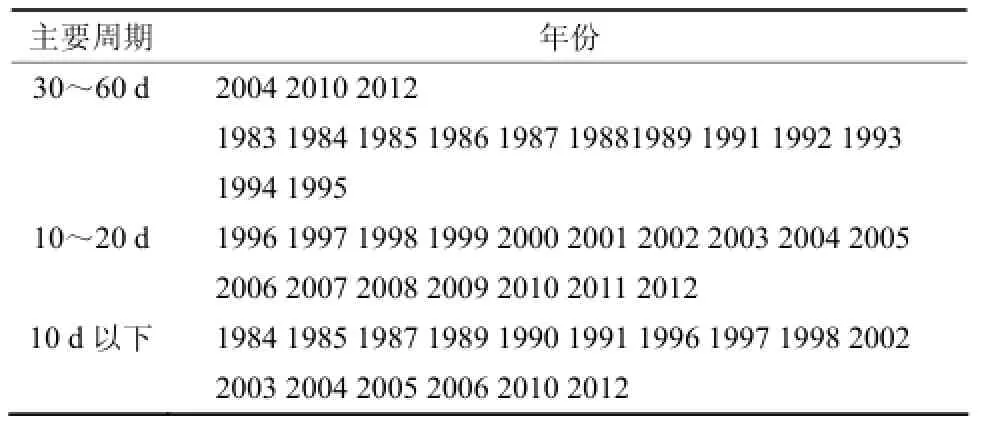
表2 小波分析夏季南亚高压纬向位置指数的主要周期(通过了95%信度检验)Table 2 The main period of index of SAH (South Asia high) longitudinal position during May to September by the Morlet wavelet analysis (at 95% confidence level)
5 夏季青藏高原大气热源低频振荡与南亚高压东西振荡的关系
5.1 夏季青藏高原大气热源低频振荡异常年的选取
为了更好的研究高原东部大气热源 10~20 d低频振荡与南亚高压东西振荡的关系,本节首先要挑出10~20 d低频振荡的强弱年,关于低频振荡的强度已有很多学者进行过研究,可用低频动能(龙振夏和李崇银,2001)以及低频能量占总能量的方差百分比(李丽平等,2009)等表示。本文采用低频方差表示低频振荡的强度(图5),以标准化序列绝对值大于等于 1.0为标准,得到大气热源10~20 d低频振荡偏强年有6年:1988、1991、1993、 1995、2000、2011年;偏弱年共4年:1994、1996、2009、2010年。由于强年比弱年的环流场特征更显著,下文主要对大气热源10~20 d低频振荡偏强年进行合成分析。

图5 1983~2012年夏季高原东部Q1 10~20 d标准化低频方差(虚线:一个标准差)Fig. 5 Standardized 10–20 d low frequency variance ofover the eastern TP in the summers from 1983 to 2012 (the dashed lines represent one standard deviation)
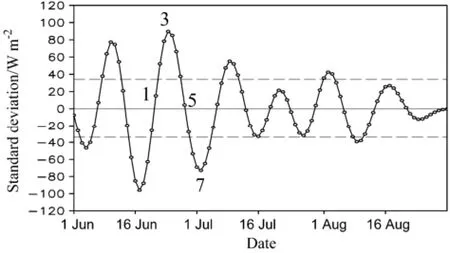
图6 2000年6~8月高原东部10~20 d滤波的时间序列(数字表示位相;虚线为一个标准差,单位:W m−2)Fig. 6 Time series of 10–20 d filteredover the eastern TP from June to August in 2000 (the numbers denote the phases of the low frequency oscillation; the dashed lines denote one standard deviation, units: W m−2)
5.2 夏季青藏高原大气热源低频振荡偏强年的高层环流场特征
使用Lanczos滤波器对6~8月高原东部大气热源时间序列进行10~20 d滤波后得到滤波曲线,参考Chan et al.(2002)的做法,将滤波曲线超过1倍均方差的循环划分成8个位相,其中第3位相表示低频波峰值,第7位相表示低频波谷值,位相2和位相4表示低频振幅达到一半时所对应的时间,位相1和位相5为转换位相(如图6),下面对夏季高原东部10~20 d低频振荡偏强年的100 hPa低频环流场进行8个位相的合成,了解高层环流场的演变情况。
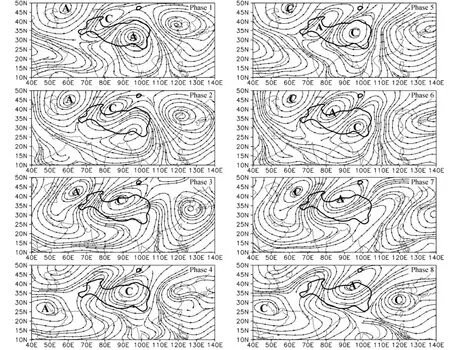
图7 夏季高原东部10~20 d低频振荡偏强年10~20 d低频100 hPa环流场8个位相的合成(位相3:峰值位相;位相7:谷值位相;单位:m s−1;字母“A”和“C”分别代表反气旋和气旋中心)Fig. 7 Composites of 10–20 d low frequency 100-hPa circulation fields during the eight phases of strong 10–20 d low frequency oscillation years ofQ1 over the eastern TP in the summer (phase 3 is the peak phase; phase 7 is the valley phase; units: m s−1; letters “A” and “C” denote the anticyclonic and cyclonic centers, respectively)
图7为10~20 d低频100 hPa环流场的合成。里海附近的低频反气旋自西向东移动,第3位相时,该低频反气旋已移到青藏高原西部,此时高原上空被低频气旋控制,导致南亚高压主要高压中心位置偏西呈伊朗高压模态。第4位相时,原来里海附近的低频反气旋位置已被低频气旋所占据,高原西部的低频反气旋主体开始向西移动并于高原西北部分裂出另一个反气旋单体。位相5及以后,该反气旋单体以及里海附近的低频气旋继续向东移动。第7位相时,高原上空已完全被该低频反气旋控制,分布形势与位相3完全相反,导致南亚高压主要高压中心位置偏东呈青藏高压模态。第8位相时,原里海附近又重新被低频反气旋控制,高原西部的低频气旋开始向西移动并于高原西北部分裂出新的低频气旋单体,与第1位相环流形势相似,新的一轮循环又将开始。10~20 d滤波后的低频环流场比未经滤波的原场更能清楚地反映南亚高压的东西振荡,进一步说明的准双周振荡与南亚高压的东西振荡之间关系密切。
青藏高原热源和 100 hPa从里海附近自西向东传播的波列究竟有何联系?根据刘屹岷等(1999)的研究,当高原东部热源异常强(弱)时,就会在加热(冷却)中心的高层西北侧激发出异常反气旋(气旋)性环流,该异常反气旋(气旋)性环流与100 hPa波列中反气旋(气旋)性环流同相叠加,使得南亚高压主要高压中心向西(东)移动,有利于伊朗高压(青藏高压)模态的形成。因此高原上空加热场异常激发的环流叠加在该100 hPa波列上将有利于南亚高压东西振荡的发生。

图8 高原东部区域平均(单位:W m−2)与100 hPa位势高度场(单位:gpm)的10~20 d滤波曲线(左列:1998、1995和2000年)以及两者的超前滞后相关(右列:1998、1995和2000年;负号表示位势高度场超前热源;零表示同期;正号表示位势高度场滞后热源)Fig. 8 10–20 d filtered curves of regionally averaged(units: W m−2) and geopotential height (unit: gpm) at 100 hPa over the eastern TP (30°–40°N, 80°–100°E) (left column) and lag correlation coefficients between them (right column) in the summer (minus denotes the geopotential height leading the Q1 ; zero denotes the same period; plus denotes the geopotential height lagging the

图9 夏季高原东部10~20 d低频振荡偏强年沿32.5°N平均的位温纬向偏差(等值线;单位:°C)和经向风(阴影:数值≤-4 m s−1的区域;单位:m s−1)8个位相的合成(深灰色阴影表示地形)Fig. 9 Composites of zonal deviation of potential temperature (contour; units: °C) and meridional wind (the areas with values ≤-4 m s−1are shaded; units: m s−1) along 32.5°N during the eight phases for years of strong10–20 d low frequency oscillation over the eastern TP in the summer (dark grey shading is for the topography)
根据热成风原理,在暖中心的东侧温度由西向东减小,有利于上层北风的发展,在暖中心的西侧温度由西向东增加,有利于上层南风的发展,因此暖区上空有利于反气旋环流的维持(任荣彩等,2004)。由图9可以看出,暖中心始终位于青藏高原西部上空200~300 hPa之间,前四位相,暖中心强度减弱范围缩小,中心略微西移,且暖中心东侧上层北风也随之减弱,由热成风原理可知,不利于青藏高压的维持,所以高压中心西移,形成伊朗高压模态;后四位相,高原西部上空的暖中心强度增强范围扩大,中心略微东移,暖中心东侧上层北风相应增强,有利于青藏高压的维持,所以高压中心东移,形成青藏高压模态。
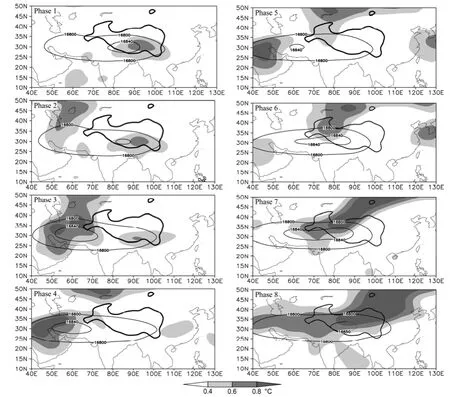
图10 夏季高原东部10~20 d低频振荡偏强年100 hPa位势高度场(等值线;单位:gpm)和500~100 hPa平均温度距平场(阴影;单位:°C)8个位相的合成Fig. 10 Composites of 100-hPa geopotential height (contour; units: gpm) and 500–100-hPa mean temperature anomalies (shading; units: °C) during the eight phases for years of strong10–20 d low-frequency oscillation over the eastern TP in the summer
对100 hPa位势高度场和500~100 hPa平均温度距平场合成后发现(图10),位相1到位相4,青藏高原上空的 500~100 hPa温度异常暖中心强度减弱,范围缩小,与此同时,来自里海以北的异常暖区域逐渐南移到伊朗高原上空,且暖中心强度增强,范围扩大,与之相对应的南亚高压主要高压中心向西移动,由青藏高压模态变为伊朗高压模态;位相5到位相8,情况恰好相反,来自巴尔喀什湖及其东北部的异常暖区域逐渐向西南扩到青藏高原上空,且异常暖中心强度增强,而伊朗高原上空的异常暖中心强度逐渐减弱,大值区向西退去,相应的南亚高压主要高压中心向东移动,由伊朗高压模态变为青藏高压模态。整个位相循环过程中,南亚高压主要高压中心始终朝着异常暖中心移动,与热成风原理暖区上空有利于反气旋环流维持的结论相一致,同时也体现出了南亚高压的“趋热性”特征。高原热力场异常导致其上空暖中心变化从而引起的风场变化可以从某种程度上解释南亚高压的东西振荡。
6 结论
本文利用1983~2012年NCEP/NCAR逐日再分析资料对夏季青藏高原和南亚高压东西振荡的低频振荡特征进行了分析,并对高原大气热源10~20 d低频振荡和南亚高压东西振荡的关系进行了初步探讨,得到以下结论:
关于季节内尺度上高原热源与南亚高压中期纬向运动的关系,本文仅是从热源对高压位置的影响这一角度进行分析,而高压强度和位置之间存在协同变化,热源对高压强度的影响也值得细致探讨。此外,夏季南亚高压具有双模态特征,它们各自又可分为东、西部型(张琼,1999),若要更加深入地研究高原大气热源季节内振荡与南亚高压中期纬向运动的关系,还应细化并分别进行讨论,这些问题有待于今后的进一步研究。
参考文献(References)
Chan J C L, Ai W X, Xu J J. 2002. Mechanisms responsible for the maintenance of the 1998 South China Sea summer monsoon [J]. J. Meteor. Soc. Japan, 80 (5): 1103–1113, doi:10.2151/jmsj.80.1103.
李丽平, 王盘兴, 管兆勇. 2009. 热带对流和环流季内振荡强度与海表温度关系对比研究 [J]. 大气科学, 33 (4): 771–782. Li Liping, Wang Panxing, Guan Zhaoyong. 2009. The comparison between relationships of intraseasonal oscillation intensity of tropical convection and circulation with sea surface temperature [J]. Chinese Journal of Atmospheric Sciences (in Chinese), 33 (4): 771–782, doi:10.3878/j.issn.1006-9895. 2009.04.11.
刘富明, 魏淑华. 2004. l00 hPa南亚高压东西振荡过程及其预报 [C]//李跃清. 青藏高原气象研究文集. 北京: 气象出版社, 56–62. Liu Fuming, Wei Shuhua. 2004. Procedure and forecasting for longitudinal oscillation of South Asia high [C]// Li Yueqing. Collected Papers of the Tibetan Plateau Meteorology (in Chinese). Beijing: China Meteorological Press, 56–62.
刘梅, 胡洛林, 濮梅娟, 等. 2007. 夏季南亚高压的演变及有关天气系统的响应研究 [J]. 气象科学, 27 (3): 294–301. Liu Mei, Hu Luolin, Pu Meijuan, et al. 2007. Study on change of South Asia high and response of other weather system during summer [J]. Scientia Meteor. Sinica (in Chinese), 27(3): 294–301, doi:10.3969/j.issn.1009-0827.2007.03.009.
Liu Xuanfei, Zhu Qiangen, Guo Pinwen. 2000. Conversion characteristics between barotropic and baroclinic circulations of the SAH in its seasonal evolution [J]. Adv. Atmos. Sci., 17 (1): 129–139, doi:10.1007/s00376-000-0049-y.
刘屹岷, 吴国雄, 刘辉, 等. 1999. 空间非均匀加热对副热带高压形成和变异的影响 III: 凝结潜热加热与南亚高压及西太平洋副高 [J]. 气象学报, 57 (5): 525–538. Liu Yimin, Wu Guoxiong, Liu Hui, et al. 1999. The effect of spatially nonuniform heating on the formation and variation of subtropical high. Part III: Condensation heating and South Asia high and western Pacific subtropical high [J]. Acta Meteor. Sinica (in Chinese), 57 (5): 525–538, doi:10.11676/qxxb1999.051.
Liu Yimin, Wu Guoxiong, Ren Rongcai. 2004. Relationship between the subtropical anticyclone and diabatic heating [J]. J. Climate, 17 (4): 682–698, doi:10.1175/1520-0442(2004)017<0682:RBTSAA>2.0.CO;2.
Liu Y M, Hoskins B J, Blackburn M. 2007. Impact of Tibetan orography and heating on the summer flow over Asia [J]. J. Meteor. Soc. Japan, 85B: 1–19, doi:10.2151/jmsj.85B.1.
龙振夏, 李崇银. 2001. 热带低层大气30~60天低频动能的年际变化与ENSO 循环 [J]. 大气科学, 25 (6): 798–808. Long Zhenxia, Li Chongyin. 2001. Interannual variability of 30–60 day low-frequency kinetic energy in the lower tropical atmosphere [J]. Chinese Journal of Atmospheric Sciences (in Chinese), 25 (6): 798–808, doi:10.3878/j.issn. 1006-9895.2001.06.07.
罗四维, 钱正安, 王谦谦. 1982. 夏季100毫巴青藏高压与我国东部旱涝关系的天气气候研究 [J]. 高原气象, 1 (2): 1–10. Luo Siwei, Qian Zheng’an, Wang Qianqian. 1982. The climatic and synoptical study about the relation between the Qinghai–Xizang high pressure on the 100-mb surface and the flood and drought in East China in summer [J]. Plateau Meteorology (in Chinese), 1 (2): 1–10.
Mason R B, Anderson C E. 1963. The development and decay of the 100-mb. Summertime anticyclone over southern Asia [J]. Mon. Wea. Rev., 91 (1): 3–12, doi:10.1175/1520-0493(1963)091<0003:TDADOT>2.3.CO;2.
彭玉萍, 何金海, 陈隆勋, 等. 2012. 1981~2000年夏季青藏高原大气热源低频振荡特征及其影响 [J]. 热带气象学报, 28 (3): 330–338. Peng Yuping, He Jinhai, Chen Longxun, et al. 2012. A study on the characteristics and effect of the low-frequency oscillation of the atmospheric heat source over the eastern Tibetan Plateau from 1981 to 2000 [J]. J. Trop. Meteor. (in Chinese), 28(3): 330–338, doi:10.3969/j. issn.1004-4965.2012.03.005.
钱永甫. 1978. 青藏高原气象论文集 [M]. 兰州: 中国科学院兰州高原大气物理研究所, 199–212. Qian Yongfu. 1978. Collected Works for Tibetan Plateau Meteorology (in Chinese) [M]. Lanzhou: Lanzhou Institute of Plateau Atmospheric Physics, Chinese Academy of Sciences, 199–212.
Qian Yongfu, Zhang Qiong, Yao Yonghong, et al. 2002. Seasonal variationand heat preference of the South Asia high [J]. Adv. Atmos. Sci., 19 (5): 821–836, doi:10.1007/s00376-002-0047-3.
任荣彩, 刘屹岷, 吴国雄. 2004. 中高纬环流对1998年7月西太平洋副热带高压短期变化的影响机制 [J]. 大气科学, 28 (4): 571–578. Ren Rongcai, Liu Yimin, Wu Guoxiong. 2004. On the short-term variation of subtropical anticyclone over the western Pacific affected by the mid-high latitudes circulation in July 1998 [J]. Chinese Journal of Atmospheric Sciences (in Chinese), 28 (4): 571–578, doi:10.3878/j.issn.1006-9895. 2004.04.09.
谭晶, 杨辉, 孙淑清, 等. 2005. 夏季南亚高压东西振荡特征研究 [J].南京气象学院学报, 28 (4): 452–460. Tan Jing, Yang Hui, Sun Shuqing, et al. 2005. Characteristics of the longitudinal oscillation of South Asia high during summer [J]. J. Nanjing Inst. Meteor. (in Chinese), 28 (4): 452–460, doi:10.3969/j.issn.1674-7097.2005.04.003.
陶诗言, 朱福康. 1964. 夏季亚洲南部 100毫巴流型的变化及其与西太平洋副热带高压进退的关系 [J]. 气象学报, 34 (4): 385–396. Tao Shiyan, Zhu Fukang. 1964. The 100-mb flow patterns in southern Asia in summer and its relation to the advance and retreat of the west-Pacific subtropical anticyclone over the Far East [J]. Acta Meteor. Sinica (in Chinese), 34 (4): 385–396.
Wang M R, Duan A M. 2015. Quasi-biweekly oscillation over the Tibetan Plateau and its link with the Asian summer monsoon [J]. J. Climate, 28 (12): 4921–4940, doi:10.1175/JCLI-D-14-00658.1.
王蕊. 2008. 南亚高压中期纬向运动过程的气候学分析 [D]. 南京信息工程大学硕士学位论文. Wang Rui. 2008. Climatological analysis on medium-range longitudinal excursion of South Asia high [D]. M. S. thesis (in Chinese), Nanjing University of Information Science & Technology.
王跃男. 2008. 夏季青藏高原热力过程对长江中下游降水低频振荡的影响 [D]. 南京信息工程大学硕士学位论文. Wang Yuenan. 2008. Effect of thermodynamic process over Tibetan Plateau on low-frequency oscillation rainfall in Yangtze River valley during summer [D]. M. S. thesis (in Chinese), Nanjing University of Information Science & Technology.
Wei Wei, Zhang Renhe, Wen Min, et al. 2014. Impact of Indian summer monsoon on the South Asian high and its influence on summer rainfall over China [J]. Climate Dyn., 43 (5–6): 1257–1269, doi:10.1007/s00382-013-1938-y.
Wei Wei, Zhang Renhe, Wen Min, et al. 2015. Interannual variation of the South Asian high and its relation with Indian and East Asian summer monsoon rainfall [J]. J. Climate, 28 (7): 2623–2634, doi:10.1175/ JCLI-D-14-00454.1.
吴国雄, 刘屹岷, 刘平. 1999. 空间非均匀加热对副热带高压带形成和变异的影响 I: 尺度分析 [J]. 气象学报, 57 (3): 257–263. Wu Guoxiong, Liu Yimin, Liu Ping. 1999. The effect of spatially nonuniform heating on the formation and variation of subtropical high. Part I: Scale analysis [J]. Acta Meteor. Sinica (in Chinese), 57 (3): 257–263.
吴国雄, 刘新, 张琼, 等. 2002. 青藏高原抬升加热气候效应研究的新进展 [J]. 气候与环境研究, 7 (2): 184–201. Wu Guoxiong, Liu Xin, Zhang Qiong, et al. 2002. Progresses in the study of the climate impacts of the elevated heating over the Tibetan Plateau [J]. Climatic and Environmental Research (in Chinese), 7 (2): 184–201, doi:10.3878/j.issn. 1006-9585.2002.02.06.
Wu G X, Liu Y M. 2003. Summertime quadruplet heating pattern in the subtropics and the associated atmospheric circulation [J]. Geophys. Res. Lett., 30 (5), doi:10.1029/2002GL016209.
Yanai M, Esbensen S, Chu J H. 1973. Determination of bulk properties of tropical cloud clusters from large-scale heat and moisture budgets [J]. J. Atmos. Sci., 30 (4): 611–627, doi:10.1175/1520-0469(1973)030<0611: DOBPOT>2.0.CO;2.
Yang H, Sun S Q. 2003. Longitudinal displacement of the subtropical high in the western Pacific in summer and its influence [J]. Adv. Atmos. Sci., 20 (6): 921–933, doi:10.1007/BF02915515.
张琼. 1999. 南亚高压的演变规律、机制及其对区域气候的影响 [D]. 南京大学博士学位论文, 148pp. Zhang Qiong. 1999. The evolvement rule, mechanism of South Asia high and its affection on the regional climate [D]. Ph. D. dissertation (in Chinese), Nanjing University, 148pp.
Zhang Q, Wu G X, Qian Y F. 2002. The bimodality of the 100 hPa South Asia high and its relationship to the climate anomaly over East Asia in summer [J]. J. Meteor. Soc. Japan, 80 (4): 733–744, doi:10.2151/ jmsj.80.733.
赵改英, 刘冰, 齐收金. 2000. 用南亚高压和西太副高的周期关系做多雨时段的预报研究 [J]. 高原气象, 19 (2): 172–178. Zhao Gaiying, Liu Bing, Qi Shoujin. 2000. Application of period relation between SAH and WPSH to forecasting Shaanxi rainy spells summer [J]. Plateau Meteorology (in Chinese), 19 (2): 172–178, doi:10.3321/j.issn:1000-0534.2000.02.006.
资助项目 第三次青藏高原科学实验项目——边界层与对流层观测GYHY201406001,江苏省高校自然科学研究重大项目14KJA170004,江苏省自然科学基金项目BK20131432,江苏省“青蓝工程”项目,江苏省“333”工程项目
Funded by the Third Tibetan Plateau Scientific Experiment: Observations for Boundary Layer and Troposphere (Grant GYHY201406001), Major Program of the Natural Science Researches for Colleges and Universities in Jiangsu Province (Grant 14KJA170004), Natural Science Foundation of Jiangsu Province (Grant BK20131432), “Qing Lan” Project of Jiangsu Province, and “333” Project of Jiangsu Province
文章编号1006-9895(2016)04-0853-11 中图分类号 P461
文献标志码A
doi:10.3878/j.issn.1006-9895.1509.15164
收稿日期2015-03-23;网络预出版日期 2015-09-06
作者简介王黎娟,女,1970年出生,博士,教授,主要从事季风和海气相互作用的研究。E-mail: wljfw@163.com.
Relationship between Low-frequency Oscillations of Atmospheric Heat Source over the Tibetan Plateau and Longitudinal Oscillations of the South Asia High in the Summer
WANG Lijuan and GE Jing
Key Laboratory of Meteorological Disaster, Ministry of Education/Joint International Research Laboratory of Climate and Environment Change/Collaborative Innovation Center on Forecast and Evaluation of Meteorological Disasters/Science and Technology Innovation Team on Climate Simulation and Forecast, Nanjing University of Information Science & Technology, Nanjing 210044
AbstractThe NCEP/NCAR reanalysis daily data for the period of 1983–2012 has been exploited to analyze the characteristics of low frequency oscillations of the vertically integrated atmospheric heat source over the Tibetan Plateau (TP) and longitudinal oscillations of the South Asia high (SAH) in the summer. The relationship between them is also discussed. Results indicate that the major low frequency cycle of heat source over eastern TP and the longitudinal displacement of SAH both are about 10–20 d. At the peak phase of the 10–20 d low-frequency heat source oscillation in the eastern plateau in the summer, 10–20 d low-frequency cyclones are dominant over the TPwhile anticyclones are dominant over the western TP. As a result, the SAH moves westward and appears as Iran high. At the valley phase of the oscillation, the low-frequency synoptic circulation pattern is completely opposite to that at peak phase. TP is under control of low frequency anticyclones while the western TP is controlled by low-frequency cyclones. Under this situation, the SAH moves eastward and appears as the Tibetan High. Wind field variations caused by changes in the warm center above the TP due to the thermal field anomalies can explain the SAH longitudinal oscillation.
KeywordsTibetan Plateau, Vertically integrated atmospheric heat source, Quasi-biweekly oscillation, South Asia high, Longitudinal oscillation
